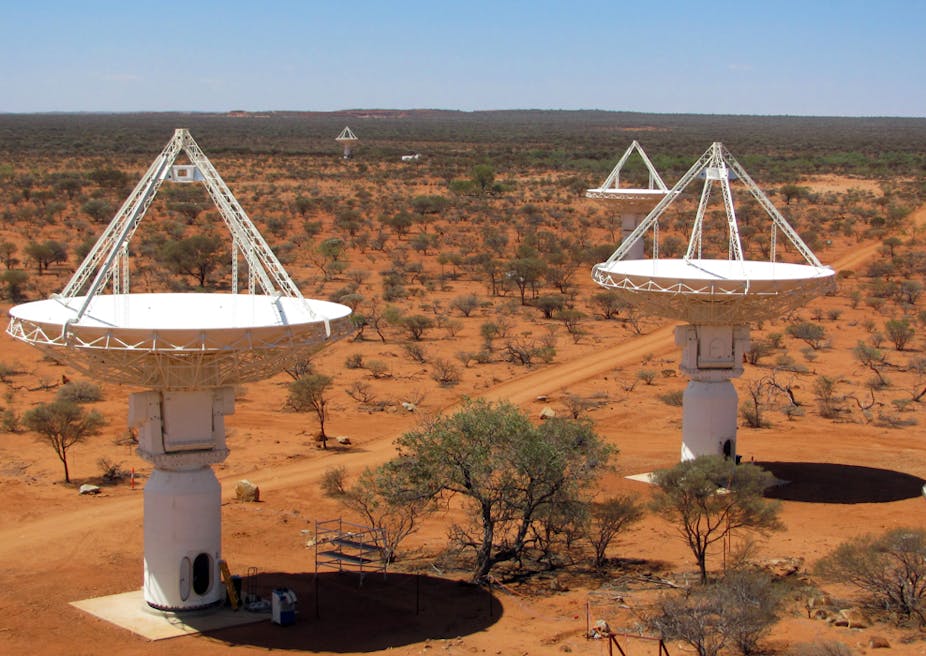We know a lot about what the universe looks like and how it works. But what we’ve been able to figure out about the cosmos is dwarfed by all the things we don’t know.
How do galaxies, stars and planets form? Where do fundamental forces such as gravity and magnetism come from? What are the mysterious “dark matter” and “dark energy” that make up 95% of the universe? And is there anyone else out there, or is Earth the only place where life has emerged and flourished?
As has been the case for hundreds of years, pushing back the frontiers of knowledge requires us to turn to increasingly larger telescopes. And if we want to answer the questions I’ve outlined above, we need to build a very large telescope indeed.
Square Kilometre Array
First proposed in 1991, the Square Kilometre Array (SKA) is a proposed giant radio telescope that will be able to truly show us how the universe formed, how it works, and who else lives in it.
As the name suggests, the SKA will have a collecting area of a square kilometre (equal to 100 hectares, or about 250 acres). But it would be impractical to build a single giant telescope, a super-sized version of the famous dish at Parkes.
Instead, the SKA will be comprised of thousands of small antennas, each one only a few times larger than a satellite dish, but all linked together electronically to simulate one giant telescope.
Working in concert, these dishes will produce torrents of data at a mind-boggling rate, enough to fill more than 5,000 160-GB iPods every second.
But buried in this avalanche of data will be faint whispers from the distant universe, which will hold the answers to some of the biggest questions in modern science.
Build and location
The SKA will take a decade to construct, will cost more than 2 billion Australian dollars, will require a continuous electricity source equivalent to the output of a modest-sized power station, and will deliver ground breaking discoveries for 50 years or more.
But where would you put such an extraordinary facility? Which country would both have the skills and technology to build an SKA?
And furthermore, who would be willing to take on the enormous risks and expenses associated with such an ambitious project?
Excitingly, the answer to these questions could well be Australia. Australian scientists have long been enthusiastic supporters of the SKA, and in recent years the Australian and New Zealand governments, all the way up to our respective Prime Ministers, have also become keen advocates.
Australia would be ideally suited to host the SKA, because the overriding requirement on the SKA site is that it be “radio quiet” – that is, that it be a place as free of possible of the everyday radio transmissions from mobile phones, microwave ovens, TV & radio stations, and even car spark plugs.
There’s simply no point building a facility as sensitive as the SKA in anywhere but the most pristine radio environment; otherwise the faint signals we would be trying to detect would be completely drowned out by all the foreground clatter.
Australia has huge swathes of land that are not only almost completely uninhabited, but which are highly likely to stay that way for the foreseeable future.
In 2005, the Federal Government established a “radio quiet zone” around the sheep station of Boolardy in outback Western Australia, with the intention of making this the site of the core group of dishes that will make up the bulk of the SKA.
Timeframe
Although the first sod of the SKA itself is yet to be turned (construction is expected to begin in 2016, with science projects starting in 2020), the dishes of the Australian Square Kilometre Array Pathfinder (ASKAP) are already taking shape at Boolardy. This is a $150 million project to build what is essentially a small version of the SKA, containing only 36 dishes.
Will ASKAP be one day replaced by the full SKA? Perhaps. In early 2012 the various international funding agencies involved in the project will announce their decision on the SKA site.
Contenders
That decision has come down to a choice between Boolardy and a competing site in the Karoo desert region of South Africa.
The two sites each have their strengths and weaknesses, but overall both are remarkably similar, making the final decision a difficult choice that may have as much to do with politics as cosmology.
Here in Australia, we think we have the edge not just because we have an ideal location, but because for decades we’ve led the world in building innovative radio telescopes and then using them to make spectacular discoveries.
Australia’s bid isn’t motivated merely by the kudos of getting to host the SKA, but by the realisation that building such a revolutionary telescope and then making it actually work will require an army of talented scientists and engineers.
Australia, with its unique combination of wide-open spaces and brilliant personnel, will hopefully soon be at the vanguard of cosmic discovery.
__For more information on the SKA, visit www.skatelescope.org; for more information on the Australian bid for the SKA, visit www.ska.gov.au. __

